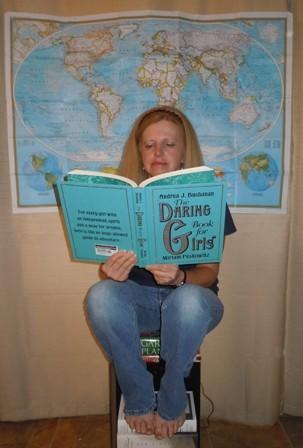Cheryl Hughes: Predictable
My friend, Sandra, asked me to set up with her at the Owensboro flea market over the weekend. (Sandra is the one who taught me how to slump bottles.) The event took place in the new convention center built on the old Executive Inn site. It was the second such event to be held in the center. I didn’t attend the first one held in March, but I understand it was a rousing success. Most of the vendors expected the same from this one. Most of the vendors were sorely disappointed.
There was speculation as to the cause of the poor turn-out: the storm that hit the area on Friday (the streets were flooded); the end-of-the month timing (money reserves were depleted); and the beautiful day following the storm (everyone wanted to be outside).
I reasoned that the first event, in March, had taken place shortly after a particularly harsh winter, and everyone was so happy about being able to get out of the house that going to a flea market seemed like a major event. (My daughter grinned as she told me I was just bad luck.)
There could be a gazillion reasons for the first big turn out and a gazillion more for the lack of interest in the second event, but the reality is you just can’t predict human behavior, especially when it comes to marketing. Think about the success of the Snuggie (a robe you put on backwards), the Slinky (a blob of coiled wire), and Crocs (comfortable yes, but otherwise, ugly plastic shoes).
This weekend, Sandra and I would take our breaks wandering through the maze of vendors, looking at what they had for sale. There were a few crafters, like we were, and some antique dealers, but most of the market consisted of cut-rate deals on stuff like athletic socks, books, cowboy hats and laundry detergent. The candy-maker, glass-etcher, and old gent gluing his fingers together with a form of super glue (demonstrating the power of his glue-removing solvent) gave the event a carnival-like atmosphere. (I looked around for the sword-swallower, but he must have gone home early.)
I looked at items similar to ones I owned just to see if I might have something valuable back at the house. There were some Royal Dalton Toby mugs like the ones my sister brought back to me on her return from England nearly forty years ago. I was amazed to learn their value had increased to one hundred ninety-five dollars apiece. There was a Gordon’s potato chip jar selling for one hundred twenty-five dollars. My mother-in-law gave me one just like it that was left over from her restaurant-owning days.
There was a guy right next to our booth selling fishing rods. I heard his pitch so many times I’ll be repeating it in my sleep for many nights to come: “Twenty dollars on the spinners and seventy-five on the boat rod. Most people think that one’s made out of split bamboo, but it isn’t, it’s a single piece of wood.” (What the heck is split bamboo, anyway?)
There were a few people looking at our bottles who were doing a kind of fishing of their own: “What kind of drill bit do you use to drill those holes? How do you feed the wire up through the bottles? Where do you get your decals?” I loved Sandra’s reply to the how-do-you-flatten-those-bottles question. “I sit on them,” she would say. (Sandra might weigh a hundred pounds, soaking wet.)
Interest at a flea market is hard to predict because it involves so many emotional levels. There are those looking for the next hot item, those looking for something from their past, and those looking for something they can use here and now. It is very much like a well-meaning mother who tries to anticipate the whims of her spoiled child. Sometimes, that child doesn’t want anything she has to offer. Predicting a flea market success is akin to betting on the futures market of the NYSE. Actually, the futures market is probably a safer bet.
- Log in to post comments



























